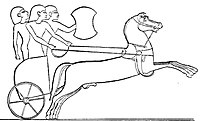Hittite military oath
More precisely, it describes a series of symbolic actions intended to represent the afflictions that should befall the oath-takers should they break their word.
The deities of the oath repeatedly invoked with the Akkado-Sumerian spelling NIŠ DINGIR (representing Hittite lengai-) are identified with the goddess of treaties Išḫara and the moon god Kušuḫ.
[3] Such parallels are evident in the following text, for example, in which a priest performs the rites, and articulates future punishments, while the soldiers express their consent.
It is more fragmentary, and its main difference is that the oath-takers are promised well-being in case they keep their word, as well as being threatened by extinction should they break it.
In comparison to the older oath, the younger text shows that the Hittite pantheon was increasingly influenced by Hurrian gods.

